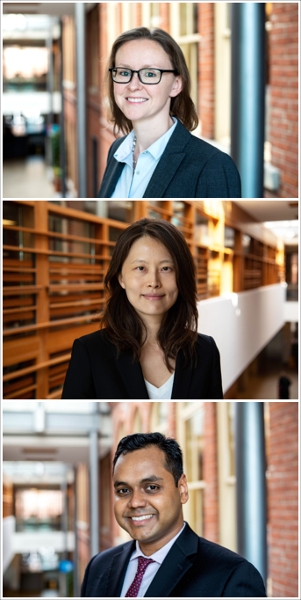Meet three new faculty at Smith
Posted on September 5, 2019
Kingston, Ont. – How does regulation affect the behaviour of financial institutions? How can analytics improve lineups for customers and businesses? And how do people make sense of often ambiguous and contradictory emotional signals in the workplace?
These are three questions that three new researchers at Smith School of Business are working to answer. Ling Yang, Laura Rees and Ragavendran (Raga) Gopalakrishnan joined the faculty of Smith over the summer. They bring to the school expertise in (respectively) accounting, organizational behaviour and operations management.
Their backgrounds are as diverse as their fields of study. Yang comes from Shenzhen, China; Rees grew up in small-town Kentucky; and Gopalakrishnan is from Chennai (formerly Madras) in India.
We asked each to tell us a bit about themselves – what they did before joining Smith and to explain their research focus:
LING YANG
Assistant Professor of Accounting
Before Smith: I was earning my PhD at Chicago Booth, and prior to that I advised institutional investors on fund manager selections.
My research: I study the regulation of financial institutions. I’m interested in this area because, first of all, it’s important. The 2008 financial crisis clearly showed that we could not rely on these institutions to discipline themselves. There’s a place for regulation in today’s financial market. Second, we do not have “clinical trials” for financial regulation. So the effects of many rules underwritten after the crisis are unclear, which, as a researcher, excites me.
What I’m working on: I have two working projects. The first is my dissertation. It shows that banks’ activities as financial intermediaries in the real economy can affect the quality of their financial and regulatory reporting. The second project studies the risk-disciplinary effects of disclosing stress-test results as mandated by the Dodd-Frank Act.
Something else about me: I’m into outdoor activities.
LAURA REES
Assistant Professor of Organizational Behaviour
Before Smith: I was assistant professor of organizational behaviour at the University of Missouri-Kansas City.
My research: I investigate emotions and other influences that often arise spontaneously and without much conscious thought, but that profoundly shape individuals’ performance and well-being at work. My interest in this research area was sparked during my time as a management consultant with the Boston Consulting Group. Many times I saw clients experiencing complex emotional and instinctual reactions to major changes, such as mergers, downsizing, large-scale strategic initiatives and other significant disruptions. Clients often had to manage these emotions on their own, and not always with good results.
What I’m working on: I recently published a paper on individuals’ responses to others expressing anger towards them, and another paper on reactions to anger, which is now in late-stage review. The first paper examines how anger from customers is received in service failure contexts. The second paper investigates how expressing anger in negotiations can lead to higher joint gains to the extent it prompts the other person to seek out more information about what can be done to resolve the situation.
Something else about me: I am a bourbon enthusiast and am happy to debate what the best bourbon is…although there is only one correct answer: Woodford Double Oaked!
RAGAVENDRAN (RAGA) GOPALAKRISHNAN
Assistant Professor of Operations Management
Before Smith: I was a postdoctoral associate at the School of Civil and Environmental Engineering at Cornell University.
My research: I’m primarily interested in two areas: service operations management, where my focus is on studying service systems with strategic entities; and pricing and revenue management, where my focus is on designing sustainable market models for modern urban mobility.
What I’m working on: At the moment, on extending a traditional queueing model to one in which both customers and servers make strategic decisions. Customers decide whether to join a queue or not based on the expected waiting time, while servers decide the rate of service based on the queue length. What are the optimal operational (e.g., queue management, routing, staffing) and economic (e.g., fees, wages) policies for maximum throughput vs. maximum profit?
Something else about me: As a gay man, I have experienced first-hand many unique hurdles facing LGBTQ students and researchers, both in their academic/work environment and in society. I am passionate about getting involved in any way that I can to address these hurdles and contribute to a strong support and mentoring framework for members of the LGBTQ community and their allies.